Publisher: Amy Marson Creative Director: Gailen Runge Editor: Lynn Koolish Technical Editors: Debbie Rodgers and Deanna Csomo McCool Cover/Book Designer: April Mostek Production Coordinator: Tim Manibusan Production Editors: Alice Mace Nakanishi, Jessie Brotman, and Jennifer Warren Illustrator: Freesia Pearson Blizard Photo Assistant: Carly Jean Marin Instructional photography by Diane Pedersen, unless otherwise noted Published by C&T Publishing, Inc., P.O. Box 1456, Lafayette, CA 94549 Dedication I owe a great deal of gratitude to the many quilters who supported me throughout this processtheir combined friendship, inspiration, guidance, and creativity have helped me with the making of this book. To my husband of 50-plus years, Fred: I cant express in words how you have stood by me all these years. Obviously, without you I would not be where I am today. To my dear daughter, Lisa, who is always willing to collaborate on new designs: Thank you for your guidance in color and composition, and your most valuable help in creating the perfect graphics. Thanks also to my son-in-law, Brian, for sharing her with me, as she has spent hours and hours on this.
To my son, Michael; his wife, Stacey; and my grandsons, Nate and Tim: Thanks for all the encouragement, support, and computer expertise. I love you all dearly. To my dear friend Jean Hall: You are always there for me. Thank you for your friendship, knowledge, writing skills, and guidance. To my lifelong friend Connie Barry, who gave me the courage and help to write quilting books: Thank you for always being willing to read a rough draft. To my critique group, Fiber Visions: Without all your help, guidance, and friendship I would not be the fiber artist I am today.
Last, but certainly not least, to my friends Judy Sabourin and Carol Ayotte: I owe you two a world of gratitude for your friendship and willingness to take a chance on any new concept or idea. I would not have been able to pull this off without your support and creativity. Thank you so much for our weeks on Cape Cod, just brainstorming and creating. PROJECT LEVELS Beginner
Beginner Experienced Beginner
Experienced Beginner Intermediate INTRODUCTION
Intermediate INTRODUCTION  Bright and bold; soft and subtle; shiny, matte, and everything in betweenthis book will show you new and exciting ways to use gorgeous fabrics and incredible colors. Whether you are a traditional quilter, art quilter, or modern quilter, there is a method and style for you in this book. Layers of shapes and colors fool the eye, allowing you to create dynamic quilts using easy construction techniques.
Bright and bold; soft and subtle; shiny, matte, and everything in betweenthis book will show you new and exciting ways to use gorgeous fabrics and incredible colors. Whether you are a traditional quilter, art quilter, or modern quilter, there is a method and style for you in this book. Layers of shapes and colors fool the eye, allowing you to create dynamic quilts using easy construction techniques.
Interactions of color and pattern will delight you. Three different construction methods can be applied to endless design possibilities. Throughout this book, youll explore options for color, style, scale, and construction. Start with one quilt and youll soon be on your way to a series. After reading this book, you will never look at fabrics the same way again. HOW IT STARTED HUGs and KISSes When we are traveling by car, my husband is most often at the wheel and I am free to doodle.
The time spent in a vehicle or on a plane always seems wasted to me unless I am piecing, beading, or doodling. For me, doodles are often the start of a new design. This particular doodle (below) became quite important, as it led to a wonderful series of quilts I call Double Vision. If you take a look at the doodle, you can see that when I disguise the corners of the squares with simple designs, wonderful circular shapes appear and the squares virtually disappear. I began to refer to these designs as cornerstones (or KISSes), and Double Vision was born.  My original doodle The First Quilt I created my first quilt, Double Vision, right after I made the doodle.
My original doodle The First Quilt I created my first quilt, Double Vision, right after I made the doodle.
I soon realized that the addition of these cornerstones made the grid disappear. But as I was working on this first quilt, I immediately had an idea for the second one, Bird of Paradise, in which I mixed the cornerstones with a grid. In that second quilt, I emphasized the grid by sewing ribbons right on the seams. 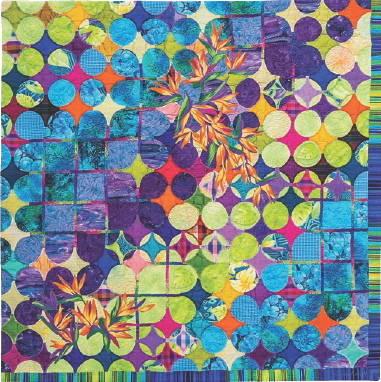 Bird of Paradise by Louisa L. Smith, 45 45 It was not until I discovered that by adding both KISSes (cornerstones) and HUGs (circles), the negative and the positive shapes started to change places. That was a great discovery.
Bird of Paradise by Louisa L. Smith, 45 45 It was not until I discovered that by adding both KISSes (cornerstones) and HUGs (circles), the negative and the positive shapes started to change places. That was a great discovery.
But please refer to Circular Anomaly for the perfect example of going from KISSes to HUGs. In fact, that was the first time I realized that it would create an Escher-type composition, because all along the idea that the negative and positive spaces trade places was evident. M. C. Escher was a Dutch graphic artist who is well known for his tessellating designs and the use of negative and positive spaces that trick the eye. One quilt led to another and another, and the series grew and grew.
Summing up this wonderful procedure is easy with just three little words: HUGs and KISSes.  HUGs and KISSes Familiar Shapes Are Everywhere The HUGs are the circles and the KISSes are the cornerstones. Another way to describe the idea is to take a good look at the gift bag (next page, top right photo). See how the circles (the HUGs) create the negative white spaces, which look remarkably familiar because they are the same shape as my cornerstones (the KISSes)? It is these negative spaces that actually inspired me to make most of the quilts in this book. And you will see these shapes in the quilts in many different ways, so keep an eye out for them. Even though I created this procedure, I soon realized that these familiar shapes were popping up everywhere.
HUGs and KISSes Familiar Shapes Are Everywhere The HUGs are the circles and the KISSes are the cornerstones. Another way to describe the idea is to take a good look at the gift bag (next page, top right photo). See how the circles (the HUGs) create the negative white spaces, which look remarkably familiar because they are the same shape as my cornerstones (the KISSes)? It is these negative spaces that actually inspired me to make most of the quilts in this book. And you will see these shapes in the quilts in many different ways, so keep an eye out for them. Even though I created this procedure, I soon realized that these familiar shapes were popping up everywhere.
And I mean everywhere. So you create circles by adding a KISS-like shape or adding quarters of that KISS-like shape to the corners of your blocks. More about that later. Working in a Series Working in a series means making a number of quilts all stemming from the same idea or design. I always work in a series because I have discovered over the years that when I create a new style of quilt and I am busily working on that quilt, ideas keep coming for the next quilt or quilts. I am always wondering, what if? What if I use larger blocks? What if I elongate the shape? What if I use several different sizes of the shape? What if I dont use blocks? What if I quilt it first? And it just keeps evolving.
When you become familiar with a subject, ideas keep coming, and, most importantly, your technique improves. It improves because it is more familiar and you learn how to handle and solve the problems that may arise. All my books have been the result of quilt series. Read on to explore the quilts and some of the possibilities these HUGs and KISSes create. Maybe youll get so inspired that youll come up with your own designs based on this technique. I am a bit smarter now, so I try to keep a notebook or sketchbook handy at all times.
Next page
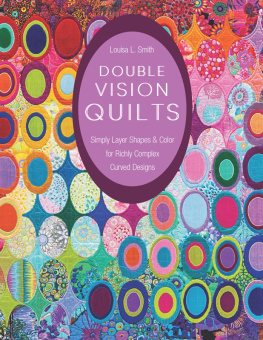






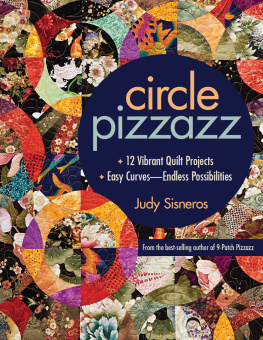
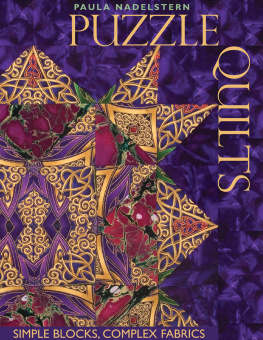
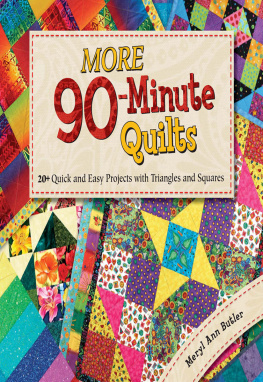

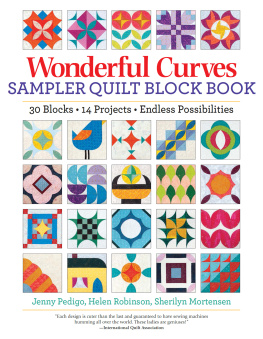
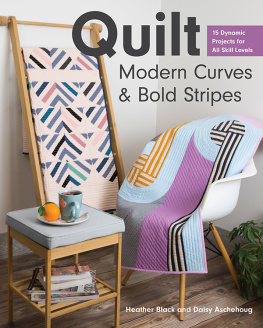
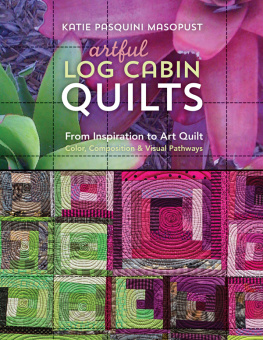
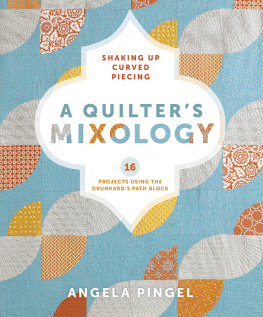
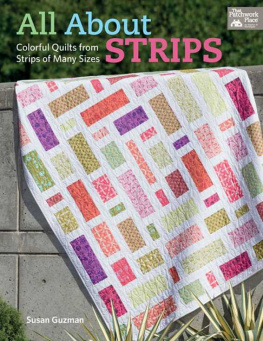
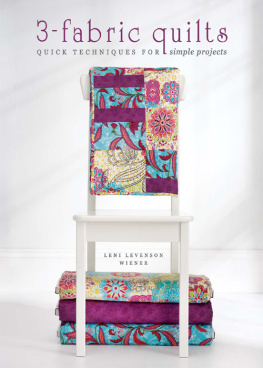
 Beginner
Beginner Experienced Beginner
Experienced Beginner Intermediate INTRODUCTION
Intermediate INTRODUCTION  Bright and bold; soft and subtle; shiny, matte, and everything in betweenthis book will show you new and exciting ways to use gorgeous fabrics and incredible colors. Whether you are a traditional quilter, art quilter, or modern quilter, there is a method and style for you in this book. Layers of shapes and colors fool the eye, allowing you to create dynamic quilts using easy construction techniques.
Bright and bold; soft and subtle; shiny, matte, and everything in betweenthis book will show you new and exciting ways to use gorgeous fabrics and incredible colors. Whether you are a traditional quilter, art quilter, or modern quilter, there is a method and style for you in this book. Layers of shapes and colors fool the eye, allowing you to create dynamic quilts using easy construction techniques. My original doodle The First Quilt I created my first quilt, Double Vision, right after I made the doodle.
My original doodle The First Quilt I created my first quilt, Double Vision, right after I made the doodle. Bird of Paradise by Louisa L. Smith, 45 45 It was not until I discovered that by adding both KISSes (cornerstones) and HUGs (circles), the negative and the positive shapes started to change places. That was a great discovery.
Bird of Paradise by Louisa L. Smith, 45 45 It was not until I discovered that by adding both KISSes (cornerstones) and HUGs (circles), the negative and the positive shapes started to change places. That was a great discovery. HUGs and KISSes Familiar Shapes Are Everywhere The HUGs are the circles and the KISSes are the cornerstones. Another way to describe the idea is to take a good look at the gift bag (next page, top right photo). See how the circles (the HUGs) create the negative white spaces, which look remarkably familiar because they are the same shape as my cornerstones (the KISSes)? It is these negative spaces that actually inspired me to make most of the quilts in this book. And you will see these shapes in the quilts in many different ways, so keep an eye out for them. Even though I created this procedure, I soon realized that these familiar shapes were popping up everywhere.
HUGs and KISSes Familiar Shapes Are Everywhere The HUGs are the circles and the KISSes are the cornerstones. Another way to describe the idea is to take a good look at the gift bag (next page, top right photo). See how the circles (the HUGs) create the negative white spaces, which look remarkably familiar because they are the same shape as my cornerstones (the KISSes)? It is these negative spaces that actually inspired me to make most of the quilts in this book. And you will see these shapes in the quilts in many different ways, so keep an eye out for them. Even though I created this procedure, I soon realized that these familiar shapes were popping up everywhere.